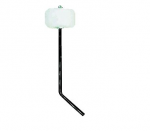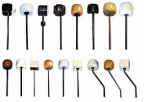Ironcobra
Platinum Member
I guess my remaining problem is that given how standard, high end bass drum pedals are configured, this is a problem that 99% of drummers should be facing. The two ways I've heard to address it are 1) to use thinner metal hoops, and 2) to adjust the spurs so, as I understood if, the whole kick is lifted off the ground and the drum remains parallel to the ground, because the resonant end of the drum is raised as high as the pedal is raising the batter end of the drum.
Problems that remain. I think most drummers use wood hoops. Are they somehow getting around the problem, or does this suggest that the "problem" isn't that severe? And second, I just don't see many drummer employing the kick drum off the ground solution. Does this again suggest that most drummers aren't addressing the issue and that it really isn't that severe?
I'm not arguing that it isn't severe; I'm simply confused on the matter.
You should be able to tilt your bass drum up about 3 or 4 degrees above parallel to the ground. This will help the problem without bending the batter side hoop. It may just be that your hoop is to wide, shave it down if you must.
If none if this works, you should decide what annoys you more. Going past the 90 degree, or having a top heavy beater.



